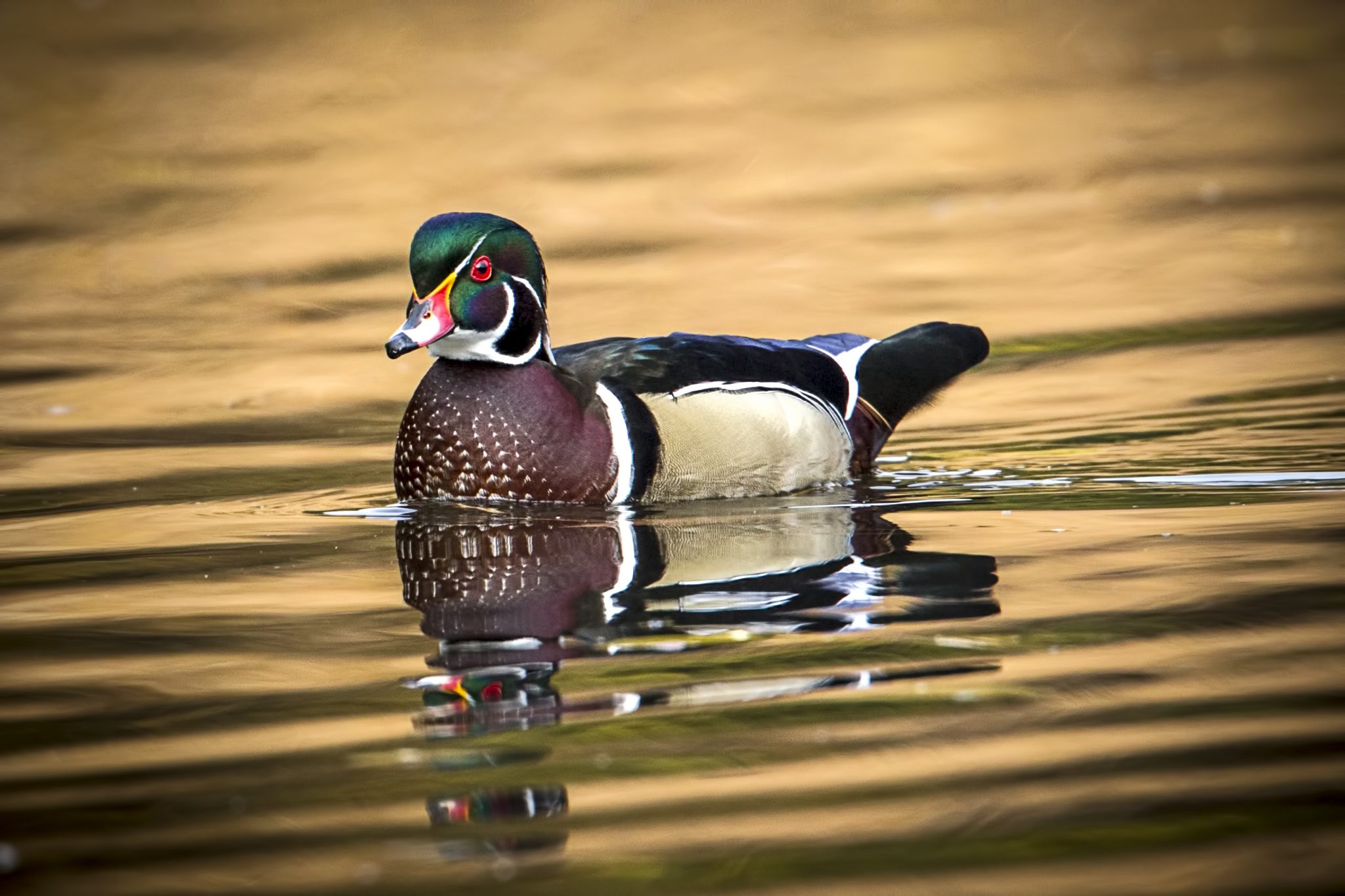Forestry & Wildlife

Learn the physical characteristics, life history, habitat needs and management, food requirements, and nesting preferences of the colorful wood duck.
More than 25 species of waterfowl occur seasonally along the coastal and inland waters of Alabama. Only one species, the wood duck, is found statewide throughout the year and nests extensively in Alabama.
On wooded wetlands and beaver ponds, wood ducks are Alabama’s most common duck. Statewide, woodies rank second only to mallards numbers harvested by hunters.
Historically, wood ducks were abundant along forested waterways throughout eastern North America. The cutting of streamside timber, the eradication of beavers, and unregulated hunting pushed the species near the brink of extinction by the early 1900s.
Strict protection measures were enacted in 1918 to curb hunting. Beavers were restocked over much of their previous range, and thousands of artificial nesting structures were erected where nest cavities were scarce.
Wood duck populations responded dramatically. The US Fish and Wildlife Service estimates as many as three million breeding pairs, and their numbers continue to grow.
Physical Characteristics
The wood duck is regarded as the most beautiful duck in North America. The breeding plumage of males or drakes contains iridescent patterns of blue, green, burgundy, black, red, and white. The plumage of females or hens is drab compared to that of drakes.
Grayish-brown feathers, disrupted only by a white chin and white eye rings, cover most of the hen’s body.
Adult wood ducks weigh about 1 pound and measure 17 to 20 inches in length. Their wings are relatively short but broad, allowing them to maneuver easily in tight, wooded cover. Wood ducks, like other puddle ducks, can immediately spring out of the water and take flight. The flight speed of wood ducks may reach 55 miles per hour.
Life History
Drake and hen wood ducks form pair-bonds by midwinter, usually during November through January in Alabama. Nesting generally begins during early February and often extends through June. Normally, eggs are laid at a rate of one per day. Once the fifth or sixth egg is laid, hens begin adding breast down to the nest. By the time the clutch is complete (usually 12 to 14 eggs) and incubation starts, the nest is covered by a blanket of down feathers.
Incubation lasts about 30 days with hens assuming all incubation duties. While hens are incubating, drakes seek secluded cover and molt their brilliant breeding plumage. During molting, drakes are flightless for about three weeks. Once molting is complete, drakes form small flocks and do not mate again until the following year.
If nests are destroyed or abandoned, wood ducks will nest again. Initial nests usually begin hatching by mid-March with a first peak hatch about early April. Occasionally wood ducks raise two broods during a breeding season.
Within 24 hours of hatching, the down-covered ducklings leave the nest. The wood duck young are able to fly at 8 to 10 weeks and soon become independent.
After rearing young, hens molt their breeding plumage. Both young and adult wood ducks gather to form small flocks during summer. By late summer, flocks increase in size, disperse, and migrate to wintering grounds. Many wood ducks hatched in Alabama remain in the state through winter, but others may scatter over the entire eastern United States.
Habitat Needs
As its name implies, the wood duck depends on woodlands, more so than any other duck in Alabama. Ideal habitat often consists of hardwood bottoms harboring permanent ponds with plenty of emergent vegetation spread among brushy cover. Small beaver ponds frequently provide good habitat in Alabama. Wood ducks feed on a variety of plant and animal materials. Leafy vegetation, seeds, and fruits form the bulk of their diet throughout most of the year. Small acorns of many oaks are important food items during the winter in Alabama. Grains of agricultural crops are readily eaten when available.
Insects, spiders, and small crustaceans are essential sources of protein for egg-laying hens and growing ducklings. These invertebrates comprise nearly 100 percent of duckling diets during their first few weeks after hatching.
Wood ducks are dabblers, meaning they feed by tipping up in shallow water. They rarely dive or entirely submerge to get food. Food items must be available within 18 inches of the water’s surface. Most feeding is done in water 3 to 18 inches deep. Wood ducks will leave the water to feed on acorns or in agricultural fields, but they prefer to feed in shallow water interspersed with brushy cover.
Wood ducks nest almost exclusively in cavities. Suitable nesting cavities must have entrances of at least 3 inches in diameter with an interior diameter of 5 inches or greater. Cavities deeper than 50 inches are rarely used for nesting. Ideal depths are about 24 inches.
Generally, higher cavities receive greater use by nesting hens, but sites as low as 6 feet are acceptable. One suitable nesting cavity per 5 acres of woodland and within 1 mile of permanent water for brood habitat is essential for good production.
Habitat Management
Landowners in Alabama can effectively attract and manage populations of wood ducks even where little opportunity exists for hunting other species of waterfowl. Production of food, particularly during winter, and establishment or retention of nest sites and brood habitat are important considerations for successful management.
Providing Food
Farm ponds. Many people interested in enhancing ponds for waterfowl are unaware of the importance of naturally occurring plants. Draining ponds during summer exposes mudflats and encourages the production of many native duck foods. When flooded in fall and winter, these shallow areas usually provide food to ducks in greater abundance and diversity than they would if they were planted with grain crops.
In newly flooded ponds, aquatic vegetation may be scarce and may require several years to become established. In such cases, seeding exposed areas to grains such as millet may increase initial use of the ponds by wood ducks.
In Alabama, Japanese millet is well adapted to poorly drained sites, and its seeds are eaten readily by wood ducks. Broadcast seed at a rate of 20 pounds per acre immediately after draining while exposed mudflats are still wet. Disking or other ground preparations are usually unnecessary.
Drain ponds June through mid-July to encourage native food production or to allow enough time for grains to mature. Draining is made easier by water level control devices. Landowners who are interested in installing such devices or who want to build ponds specifically for ducks should contact the USDA Natural Resources Conservation Service (NRCS). NRCS employees will provide free engineering advice on pond construction.
Beaver Ponds
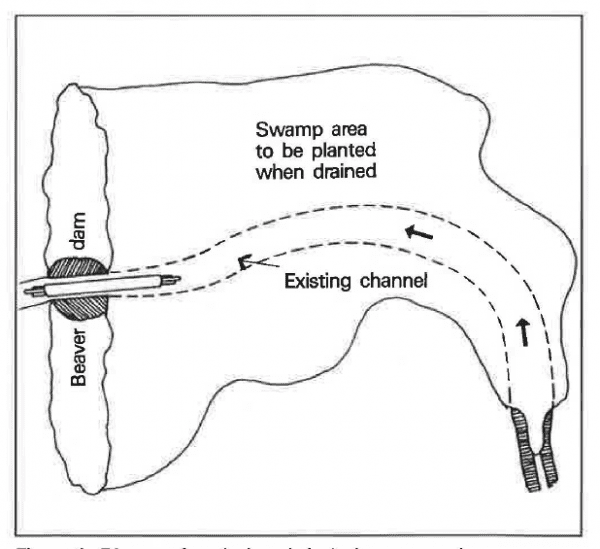
Figure 1. Diagram for placing drain in beaver pond.
Beaver ponds are excellent for converting into either green tree reservoirs or Japanese millet feeding areas. If beaver ponds in woodland areas are new and trees are not dead, they can be converted into green tree reservoirs to attract wood ducks without any loss to timber production.
Acorns are a preferred food of wood ducks. Beaver ponds with acorn-producing oaks can be drained with a three-log drain during the growing season to prevent trees from dying. During the dormant season, remove the drain and allow the beavers to rebuild the dam. The shallow water area is then attractive to ducks as feeding areas.
Older beaver ponds, where trees are already dead, can be made into attractive duck feeding areas by draining them with a three-log or corrugated plastic drain and establishing Japanese millet in them.
To build and install a drain in ponds where trees are dead, follow these instructions:
1.Check the area to determine if there is at least 1 acre of shallow water that is 2 to 30 inches deep (figure 1).
2. Break dam at the existing channel from mid-June to the end of July. Make the break in the form of a narrow, deep V.
3. Let the water drain from the pond area. When the swift flow of the water has become slack enough to work with ease, build and install the three-log or corrugated plastic drain as follows:
Three-Log Drain
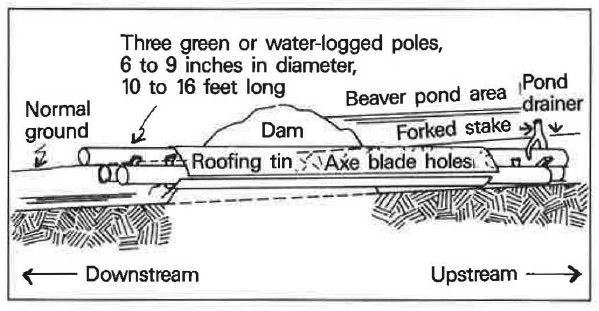
Figure 2. Plan for building a three-log drain.
Fasten three logs together with nails and short pieces of wood (figure 2). Logs should be 6 to 9 inches in diameter and 10 to 16 feet long.
Place a 24-inch-wide and 6- to 8-foot-long piece of tin in the dam break.
Place the three-log drain on top of this tin with the upstream logs completely covered by water and at least 1 foot lower than the downstream end of the drain. Peg down the upstream end of the drain with a forked stick.
Place a 24-inch-wide and 6- to 8-foot-long piece of tin over the top of the logs and nail to the bottom two logs. Make several axe blade holes throughout this piece of tin. Beavers usually cannot repair the dam break once the three-log drain is installed.
Corrugated Plastic Drain
Buy a piece of corrugated plastic pipe, 12 inches in diameter and 10 to 16 feet long.
Cut 2- to 3-inch-diameter holes in the pipe about every 8 to 12 inches on all sides and along the total length.
Place in the dam as described for the three-log drain above.
4. Sow Japanese millet seed on the exposed mudflats at a rate of 20 pounds per acre. The ground should be moist. Best conditions occur when the beaver pond is about ankle-deep in mud. No further land preparation is needed and fertilization is not needed in the first two years.
Caution: Do not use any substitute for Japanese millet (Echinochloa esculenta) seed. Brown top millet, proso millet, and starr millet will not grow well, if at all, in the extremely wet soils of typical beaver ponds.
5. Check drains about once a week to be sure they are working properly.
6. Remove drains after seeds mature. Seeds usually mature in 45 to 60 days. Once drains are removed, beavers will repair the dam and the millet will be flooded for ducks.
7. Drain the pond each summer so that the Japanese millet seeds can germinate and grow. In many ponds, the original seeding provides enough hard seed so that reseeding is not necessary over a three-year period.
Seasonally flooded hardwood bottoms. Seasonally flooded hardwood bottoms are also attractive to wood ducks. Wood ducks frequent such areas, particularly during fall and winter, to feed on acorns. The use of bottomland hardwoods may be enhanced by culling unproductive trees and creating small openings.
Retain oak species such as water oak and willow oak, which bear small acorns. Where possible, millets, corn, and grain sorghum may be planted in bottomland openings. This will add a further variety of food and offset the effects of potential mast failures.
Providing Nest Sites
Cavity-prone, mature hardwoods needed as nest sites by wood ducks are scarce in many areas of Alabama. Fortunately, wood ducks nest readily in artificial nesting structures. Properly built, located, and maintained nest boxes can effectively increase wood duck production (figure 3).
Many wood ducks should not be counted on the first year or two after nesting boxes are erected. Wood ducks have a strong tendency to return to the vicinity where they were hatched to nest. Use boxes sparingly and place them so they are not conspicuous. This will tend to reduce dump nests and maintain good production on a long-term basis. A maximum of one box per pond acre is recommended.
The nesting box should be constructed of 1- x 12-inch rough cypress, redwood, or treated PME lumber. A lid should cover the top of the box. To make inspections easier, install with hinges down. Also include hooks on the lid to properly secure it.
The finished box should be 20 to 22 inches deep and 10 feet square on the inside. Cut a 4- x 3-inch oval entrance hole (lying horizontally) with its bottom about 16 inches from the box bottom. Drill 2- or 3-inch holes in the box bottom for drainage.
Place 4 inches of sawdust or wood shavings in the box. A 2-inch-wide piece of 1-inch hardware cloth can be nailed inside the box between the entrance hole and the box bottom. This is necessary only if dressed lumber is used to provide the young ducklings traction to climb out of the box after hatching.
Place boxes at least 6 feet above the water on trees or poles. A metal predator guard is extremely important (figure 4). Nesting boxes erected without predator guards serve as death traps for nesting wood ducks and their eggs.
Erect boxes before February and place in highly visible areas near good brood habitat. Adequate protective cover near nest boxes is essential for brood survival. Brood habitat should include a stable source of water with plenty of shrubs and emergent vegetation for food and cover.
Inspect boxes at least once each year. During early January, replace old nest material with 4 to 5 inches of fresh sawdust, wood shavings, or soft hay. Check boxes again during early spring to determine use by wood ducks.
Plans and Materials for Building Wood Duck Nesting Box
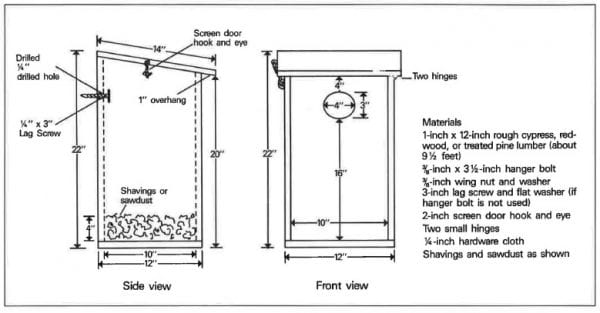
Figure 3. Plan for building a wood duck nesting box.
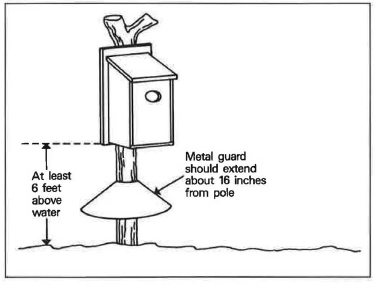
Figure 4. Erecting a wood duck nesting box.
Harvesting
Frequent and prolonged shooting over the same pond may discourage wood ducks from feeding there. If possible, confine hunting over feeding areas to morning hours and allow wood ducks to feed undisturbed during the afternoon. Do not hunt duck more than once a week over small areas.
 Revised by Bence Carter, Regional Extension Agent, Forestry, Wildlife, and Natural Resources, Auburn University. Originally written by Lee Stribling, former Extension Specialist.
Revised by Bence Carter, Regional Extension Agent, Forestry, Wildlife, and Natural Resources, Auburn University. Originally written by Lee Stribling, former Extension Specialist.
Revised July 2021, Wood Duck Management In Alabama, ANR-0519

